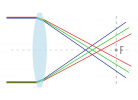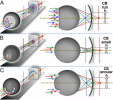D
Deleted member 619
Guest
Physics pedant interjection for clarity:Also, just a side note: Cephalopods can actually distinguish between different colours. When light passes through virtually any lens, the colours separate like how a prism does. This is called chromatic aberration. But cephalopods managed to make use of this.
This isn't called chromatic aberration. The way light separates is called refraction, which varies by medium (each medium having a refractive index detailing how it separates and at what angles).
Chromatic aberration is the resultant phenomenon of light focusing at different points after having passed through a lens, i.e., having come back to focus imperfectly because it's functionally impossible to build a perfect lens. Very closely related, the one being a function of the other, but I know you value clarity as much as I. You weren't incorrect, exactly, but the nomenclature was potentially confusing.


